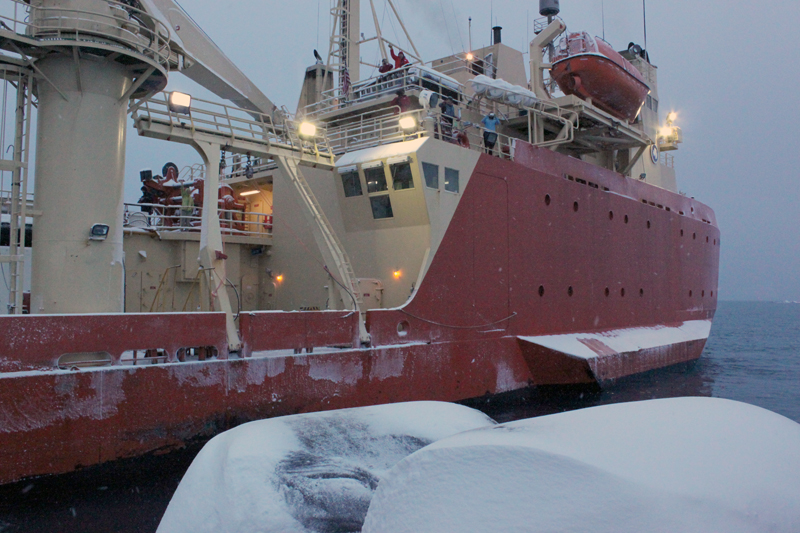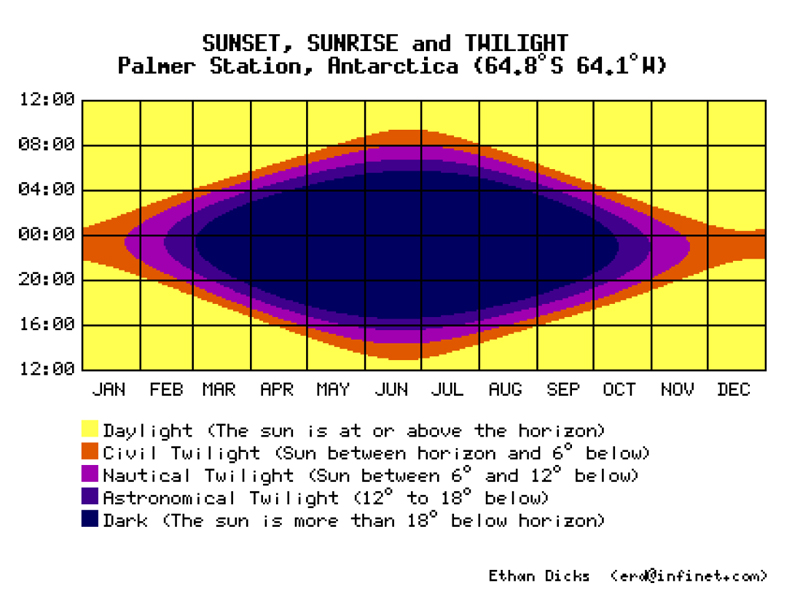
Recently, the Laurence M. Gould sailed north fulfilling the inevitable cycle of arriving at Palmer, making new friends, then months later sailing away. The departure scene is the same, though the names of those on the ship’s deck waving goodbye, sometimes tearfully, change. In June, our team members will be the ones on deck waving back to our land–bound friends and watching Palmer shrink as the ship steams out to sea. Like most modes of transportation ship schedules are subject to change and the LMG’s may be delayed or even moved ahead. Schedule changes though will not alter the impact of the bittersweet cycle.
Life at Palmer Station is governed by cycles, most of which are not under our control. The light-dark cycle is probably the biggest governor at Palmer. The available daylight is rapidly diminishing. Today, sunrise was at 10:02 and sunset at 4:25. Prepping the zodiac for use is now done at dawn (see CJ below); tucking the boat in at the end of the day is at dusk as we must be off the water an hour before sunset.

Latitude determines how much sunlight we could see. Weather, a.k.a. clouds, regulates how much of it we will see. Not much lately. Below is a graphic illustrating the annual solar cycle computed for Palmer’s latitude, 64oS. The months of the year are along the bottom and hours (noon-noon) on the left side. Each black bordered rectangle represents four hours. The darker the color fill within the rectangle, the less sunlight there is. Look at the blocks above May and note how little yellow, indicating daylight there is. Most of the blocks represent dawn, dusk or night. There is even less daylight in June. More daylight would make our diving-based science easier but it is on a scheduled cycle we cannot change.

We can however cheat Mother Nature a little by creating our own little solar cycle. I am maintaining two experiments under more summer-like conditions using a lighted, temperature controlled incubator (see below). This artificial southern summer’s solar cycle is 12 hours light and 12 hours dark. One of the experiments, in the small dishes top shelf, is investigating whether the different chemogroups of the red alga Plocaminum cartilagineum (see CJ’s “Laundry” post) have different growth rates. The other experiment is a miniature version of mesocosm experiment Michelle described (“Aquarium and Blizzards”) with a slight modification. Rather than exposing large sections of the brown alga Himantothallus grandifolius to a mixed population of snails, we are maintaining small disks of the alga with an unnaturally high number of a single snail species. This might help us understand the ecological role of the more dominant snails.

The incubator also controls temperature and the summertime water temperature setting is 1 oC/34oF. Water temperature, like day length, is another cycle we cannot alter. Below is another chart illustrating the slight variation in Palmer’s surface seawater temperature (left vertical scale) throughout the hours of the day (horizontal scale). Basically, the water temperature ranges from ‘warm’ (-0.8oC/ 32oF at 1300/1pm) to ‘cold’ (-1.45oC/ 29oF at 2000/8pm). This narrow ranging temperature cycle suggests afternoon dives will be the ‘warmest’! Brrrrrrilliant observation, eh?!!

The Webster dictionary defines cycle not only as a noun meaning a “recurring succession of events or phenomena” but also as a synonym for bicycle and as a verb to bicycle. You may be surprised to know that Palmer has bicycles and thus bicycling. Wow – you can bicycle in Antarctica??? Yes you can and most mornings here, like many at home, I pedal to work. Well, sort of here – the bike I ride is in the gym and it is stationary. The bike goes nowhere, my legs pedal round and round while my mind roves the galaxy in the now dark of early pre-breakfast morning rides.
Since 2007, Antarctica has participated in an international cycling event. Honest! In 2007, I received permission to register Palmer Station as a host ‘city’ for the Ride Of Silence. This annual event seeks to commemorate cyclists killed or injured while cycling on public roadways, raise awareness to share the road with cyclists, and to celebrate the simple joy of cycling. Below is Chuck and a fellow Palmerite pedaling the Ride of Silence 2017.

This year, I am so pleased to announce that not only Palmer but also our sister station South Pole will saddle up at 7 PM Wednesday 16 May to pedal for this event. Antarctic cyclists will spin in stationary unison with thousands of cyclists in hundreds of city across six continents pedaling the streets to promote safe cycling. All seven continents riding in spirit for a single cause! This is one cycle that you can help have a positive local, even global impact. Interested in joining the ride? Check out the Ride of Silence website for an event near you or to register your hometown as a new location. Cycle on, pedal happy!